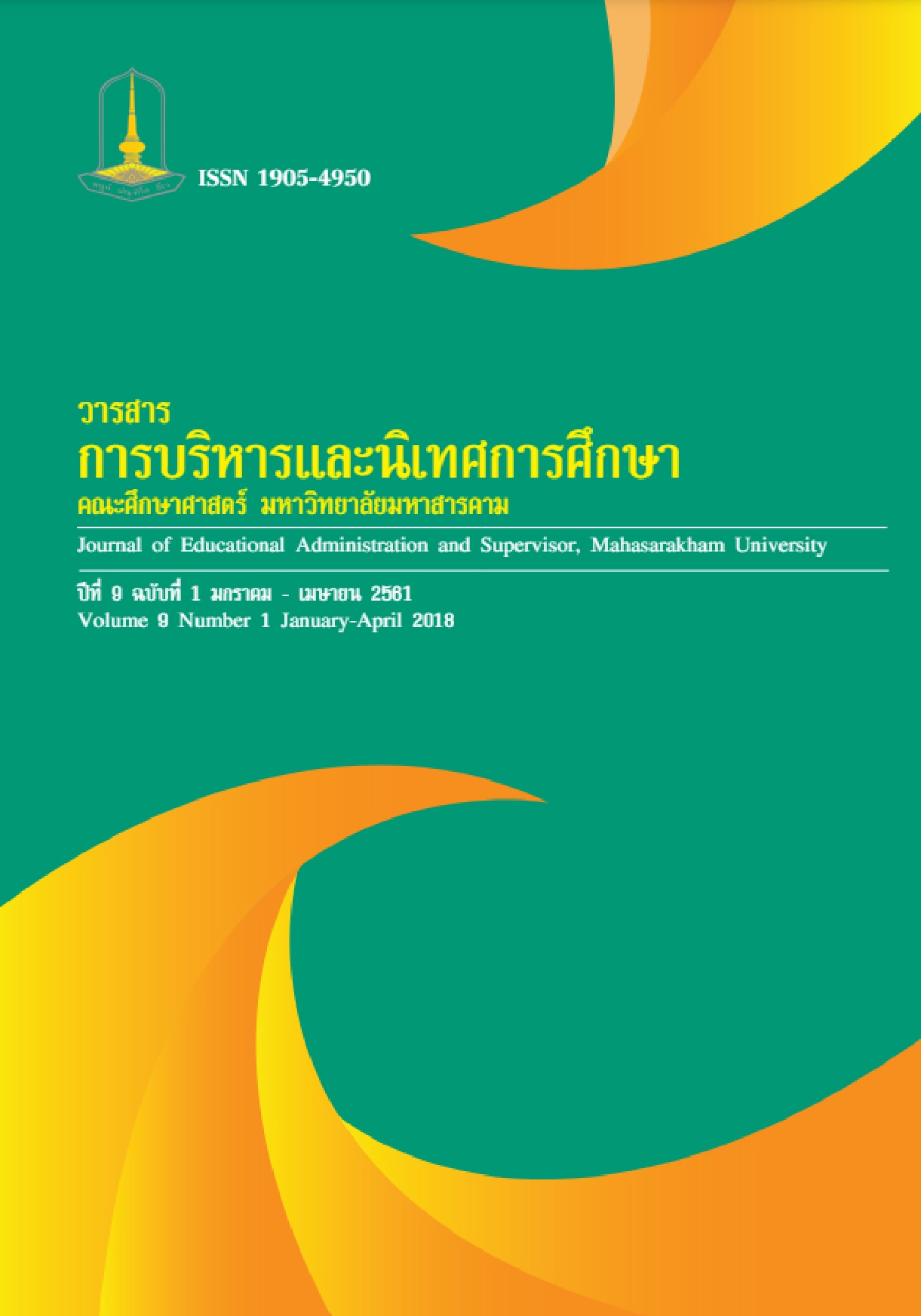The guideline of developing a teacher development program in science educational learning design for students’ self discovery learning for schools in nakhon phanom primary educational service area office 2
Main Article Content
Abstract
The purposes of this study were (1) to examine the components and the indicators in science educational learning design for students’ self-discovery learning, (2) to examine the current states and the desired states in science educational learning design for students’ self-discovery learning for schools, and (3) to develop a teacher development program in science educational learning design for students’ self-discovery learning for schools under Nakhon Phanom Primary Educational Service Area Office. The participants of this study were 5 experts by the Purposive Sampling, 127 science teachers from schools under Nakhon Phanom Primary Educational Service Area Office 2 by the multi stage sampling, and 5 teachers from best practice school by the Purposive Sampling. The instruments were the questionnaire to investigate the current states and desired states, structured interview, and appropriateness evaluation form. The statistics used in this study was Percentage, Mean, and Standard Deviation.
The results are (1) The study of the components and the indicators in science educational learning design for students’ self-discovery learning, as as whole, was at the high level. It is found that there were 7 components and 47 indicators. (2) The current state in science educational learning design for students’ self-discovery learning for schools in Nakhon Phanom Primary Educational Service Area Office 2, as a whole, was at the low level, and The desired state in science educational learning design for students’ self-discovery learning for schools under Nakhon Phanom Primary Educational Service Area Office 2, as a whole, was at the high level. (3) Teacher development program in science educational learning design for students’ self-discovery learning for schools under Nakhon Phanom Primary Educational Service Area Office 2 comprised of 6 components. They were: 1) studying students’ problems/needs, 2) identifying objectives, 3) determining content/main point, 4) determining strategies, 5) learning activities, 6) determining evaluation and assessment, and 7) taking feedback to improve. The program assessed by the experts was usefulness at the highest, possibility and reasonability were at the high level.
Downloads
Article Details
References
กิดานันท์ มลิทอง (2540). เทคโนโลยีทางการศึกษาและนวัตกรรม. กรุงเทพฯ: จุฬาลงกรณ์มหาวิทยาลัย.
ชูชัย สมิทธิไกร (2550). การฝึกอบรมบุคลากรในองค์กร. พิมพ์ครั้งที่ 5. กรุงเทพฯ: สำ นักพิมพ์แห่งจุฬาลงกรณ์มหาวิทยาลัย.
ฐีระ ประวาลพฤกษ์. (2538). การพัฒนาบุคลากรและการฝึกอบรม (Personnel development and Training). กรุงเทพฯ: หน่วยศึกษานิเทศก์ สำนักงานสภาสถาบันราชภัฏ.
ทิศนา แขมมณี. (2547). รูปแบบการเรียนการสอนทางเลือกที่หลากหลาย. กรุงเทพมหานคร:ด่านสุทธาการพิมพ์.
ธนานันต์ ดียิ่ง. (2556). โปรแกรมการพัฒนาสมรรถนะครูระดับการศึกษาขั้นพื้นฐาน ด้านการวัดและประเมินผลในชั้นเรียน. วิทยานิพนธ์ กศ.ด., สาขาวิชาหลักสูตรและการสอน, มหาวิทยาลัยศิลปากร, นครปฐม.
ปัญญา แกล้วกล้า. (2547). การพัฒนาชุดฝึกอบรมเรื่องกระบวนการจัดทำหลักสูตรสถานศึกษาขั้นพื้นฐาน (A training package development for basic curriculum construction process. วิทยานิพนธ์ กศ.ด., มหาวิทยาลัยศิลปากร, นครปฐม.
พิมพันธ์ เดชะคุปต์ และพเยาว์ ยินดีสุข (2550). ทักษะ 5C เพื่อการพัฒนาหน่วยการเรียนรู้และการจัดการเรียนการสอนแบบบูรณาการ. กรุงเทพฯ: สำนักพิมพ์แห่งจุฬาลงกรณ์มหาวิทยาลัย. สถาบันทดสอบทางการศึกษาแห่งชาติ (องค์การมหาชน). รายงานผลการทดสอบทางการศึกษาระดับชั้นขั้นพื้นฐาน (O-NET) ชั้นประถมศึกษาปีที่ 6. สืบค้นเมื่อ 27 มิถุนายน 2559, จาก http//www.niets.or.th.
สถาบันส่งเสริมการสอนวิทยาศาสตร์และเทคโนโลยี. (2545). คู่มือการจัดการเรียนรู้กลุ่มสาระการเรียนรู้วิทยาศาสตร์. กรุงเทพฯ: สถาบันส่งเสริมการสอนวิทยาศาสตร์และเทคโนโลยี.
สำนักงานเขตพื้นที่การศึกษาประถมศึกษานครพนม เขต 2. (2559). รายงานผลการจัดสอบ O-NET ปีการศึกษา 2558 ชั้นประถมศึกษาปีที่ 6 และชั้นมัธยมศึกษาปีที่ 3.
สำนักงานรับรองมาตรฐานและประเมินคุณภาพการศึกษา(องค์การมหาชน). (2550). ํ หลักเกณฑ์และ วิธีการประเมินคุณภาพภายนอกของสถานศึกษาขั้นพนฐาน. กรุงเทพฯ: สมศ.สำนักงานรับรองมาตรฐานและประเมินคุณภาพการศึกษา.
สำนักวิชาการและมาตรฐานการศึกษา สำนักงานคณะกรรมการการศึกษาขั้นพื้นฐาน กระทรวงศึกษาธิการ. (2551). ตัวชี้วัดและสาระการเรียนรู้แกนกลาง กลุ่มสาระการเรียนรู้วิทยาศาสตร์ ตามหลักสูตรแกนกลางการศึกษาขั้นพื้นฐาน พุทธศักราช 2551. กรุงเทพฯ: กระทรวงศึกษาธิการ.
สุเทพ อ่วมเจริญ. (2559). การพัฒนาหลักสูตร: ทฤษฎีและการปฏิบัติ. นครปฐม: โรงพิมพ์มหาวิทยาลัยศิลปากร วิทยาเขตพระราชวังสนามจันทร์.
Glasser, Robert., (1962). Teaching machine and program learning II. Pittsburgh: University of Pittsburgh Press.
Krejcie, R. V., & Morgan, D. W. (1970). Determining Sample Size for Research Activities. Educational and Psychological Measurement, 30(3), 607-610.
Mager, R. F., (1975). Preparing instructional objectives (2nd ed.). California: Pitman Learning.
Oliva, P.F., (1992). Developing the Curriculum. (3rd ed.) New York: Hatper Collins.
Saylor, J.G, Alexander, W.M. (1974). Planning Curriculum For Schools. New York: Holt, Rinehart and Wiston.
Stake, Robert E. (1973). The Countenance of Education Evaluation,” in Education Evaluation: Theory and Practice. Belmont: California Wadsworth Publishing Company.
Stufflebeam, Daniel L. (1971). The Relevance of the CIPP Evaluation Model for Educational Accountability. Atlantic City, N.J.
Taba, H., (1962). Curriculum Development: Thorey and Practice. New York: Harcourt Brace & World.
Tyler, Ralph W., (1949). Basic Principle of Curriculum and Instruction. Chicago: The University of Chicago Press.


